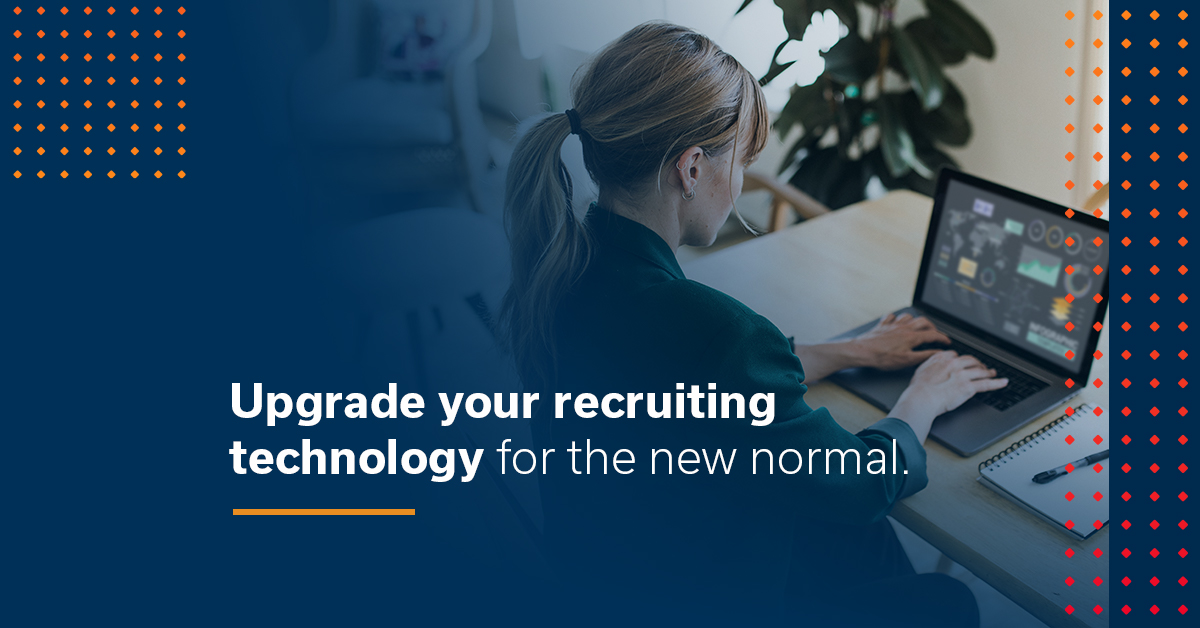In the first half of 2020, many business and HR leaders have made significant decisions and investments to adapt their recruiting systems and processes. Organizations needed to quickly adjust their strategies and expectations to properly support a near 100% remote workforce overnight. The most important question that executives have been asking themselves: were those decisions and technology investments the RIGHT moves to support a long-term remote work plan?
While many executives have been toying with the idea of upgrading their legacy recruiting systems and processes for quite a while, the majority have not had the time or ROI justification to support this funding request. Fortunately, the outbreak of COVID-19 has created a perfect business case for leaders to inquire about these new investments. As businesses settle into a new normal of long-term uncertainty, these recruiting tools will be essential for driving bottom-line profitability while managing costs in a more transparent and agile world.
Now is a great time for businesses to perform a current state gap assessment on their recruiting and HR systems and processes. Identifying automation opportunities could prove to be crucial in generating cost savings, improving the user experience through better training and retaining of candidates, and discovering systems and process optimization tweaks to gain more efficiency.
TalentRise has conducted many of these same gap assessments for our clients. Below are some tips to help guide your organization if you seek to perform your own internal review:
Always start with understanding the future state vision of how you want your systems to work in the IDEAL future state.
Once this step is complete, evaluate that against the company’s strategic priorities and business growth plan over the next 3-5 years. With this lens, you may identify different system needs or considerations to be aware of.
EXAMPLE: A company growing through M&A may have a greater need for systems that integrate easily with existing platforms and are more user-configurable in adapting to constant updates and changes in the process.
Identify those legacy systems that no longer meet the needs of the business.
In our more virtual world, flag these systems for replacement or upgrade them when your budgets permit. Ultimately, you should examine each system through the lens of its end users.
Be sure to get input from all stakeholder groups.
The stakeholders who interact with the systems should have buy-in when changes are being recommended. Many times, when IT or HR is driving this kind of initiative, they only solicit input from IT- and HR-related stakeholders, ignoring the fact that the business has many other people who rely on these systems. On other occasions, HR will buy an existing vendor’s product upon recommendation from IT or procurement. Even though the system may be easier for IT to turn on or is more affordably priced in the eyes of procurement, it may not be the best solution for your needs. Your goal should be to choose a system with functionalities that minimize or eliminate current manual workarounds that are enacted to achieve your goals.
Create a quick, less-than-20-question online survey followed by select focus groups and/or stakeholder interviews to clarify or gain deeper insights into the survey findings.
This will help you gain better insights into your survey findings. From job candidates and recent hires to long-term employees and executive stakeholders, each group will have a different perspective on how well the current platforms support their needs. They’ll also have opinions on the quality of the user experience when utilizing the systems. As a start, TalentRise provides a FREE Recruitment Diagnostic Gap Assessment, which takes less than five minutes to complete. Your responses will generate a “best practice” score to guide your efforts to improving your recruiting systems.
Create a clearly defined requirements document BEFORE you go systems shopping.
Form a cross-functional technology selection committee to rate each vendor demo using your requirements document as a guide. Be cautious not to let the loudest voice or the person with the most senior role in your group override the majority when debating final decisions. These opinions are often rooted in fear of change, as having to learn something new can be daunting for your employees. Don’t feel obligated to comfort your employees by maintaining systems that they have worked within the past. If you feel that your business can be optimized with a new system, take the leap of faith – your workers will come on board soon after.
Use a simple RED, YELLOW, GREEN rating system.
This can be implemented when evaluating your current practices and systems capabilities against your desired future state goals and system functionality. Ultimately, this will facilitate future prioritization and action planning. Red signifies a practice or system feature/functionality that does not exist or is ineffective, yellow represents something that exists but needs improvement, and green means that the practice or functionality exists and is working well.
When reporting out your gap assessment findings, be sure to include external relevant benchmark reference data points where appropriate.
There are an abundance of FREE benchmark studies and best practice research reports that are publicly available to compare, validate, and support your assessment findings. Moreover, these external reference points will provide the necessary context and credibility to justify your investment recommendations for business improvement and enhancement.
All recommended investments should be supported by a financial business case and timeline.
Upon request, an executive summary of a system’s key features and estimated timeline to achieve a target ROI can often be provided free of charge by most vendors who provide a formal bid. If you’re looking to get a back-of-the-napkin ROI impact on a system purchase, you can estimate how much faster the hiring process will be improved (in number of days) or the amount of savings that can be generated by reducing reliance on third-party vendors (i.e. contingent search firms) by an estimated percentage reduction from current spend.
To calculate the daily cost of a vacant position, you can simply use the following formula:
- Annual Revenue / # Employees / 365 Days = daily revenue generated by each employee
To compute the $ savings generated by reducing time to hire by X # of days:
- Average current # days to fill an open position X daily revenue per employee (from above) = Average current cost of a vacant position
- Average cost of a vacant position X number of open positions annually = Total annual cost of open and unfilled jobs (vacancy)
- If you estimate that the technology investment will reduce time-to-hire by 10%, you can then take 10% off the projected total annual cost of vacancy and compare it to the proposed investment to assess ROI impact.
Measure actual ROI post-implementation.
For organizations with a “Best of Breed” multiple talent system philosophy, be sure to consider an investment in a robust workforce analytics and planning tech platform like HCMI.co or Visier.com. This will save your organization from building out hundreds of your own workforce dashboard reports in Tableau, Excel, or Microsoft Power BI.
With an investment in a workforce analytics platform, companies can reap the following benefits:
- Receive valuable, real-time insights on the correlation between people data, bottom-line business performance, and financial impact.
- Access the vendor’s team of seasoned, talent-savvy data scientists “on-demand.”
- Most of these analytics platforms come pre-configured with hundreds of pre-built workforce analytics dashboards, reports, and algorithms that can be easily and quickly integrated and customized to your needs.
- Data can be automatically pulled from your various disparate people and financial systems into one, intuitive, online dashboard.
- The vendor’s datasets often include hundreds of HR benchmarks and external data to compare your performance to that of your competitors or target industries.
Prepare for implementation and change management.
Once you have approval to move forward with your technology upgrades, be sure you have the expertise and bandwidth within your team to successfully partner with the right service provider. This implementation and change management process will take time, so remain patient. To support your efforts and minimize the risk of a failed implementation, consider partnering with an implementation consultant like TalentRise. We can take over in leading the project but can also provide over-the-shoulder expert advisory consultation to fill experience gaps on your internal implementation team and help to prevent costly system configuration design mistakes from occurring.
Carl Kutsmode is a Senior Vice President of Talent Consulting at TalentRise, a talent optimization management consulting and retained executive search firm based in Chicago. Carl is the host of Talent Tech Today, a monthly video blog that features prominent founders from innovative yet lesser-known HR and talent technology companies. TalentRise helps employers improve business results and performance through talent.




